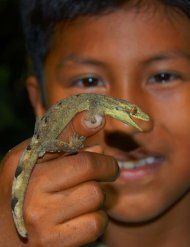2006-2007 - The Field Museum
2006-2007 - The Field Museum
2006-2007 - The Field Museum
Create successful ePaper yourself
Turn your PDF publications into a flip-book with our unique Google optimized e-Paper software.
graduate student advising and dissertation supervision. Among the graduate students mentored and<br />
advised by <strong>Field</strong> <strong>Museum</strong> curators is a core group of graduate students whose work is squarely based in<br />
<strong>The</strong> <strong>Field</strong> <strong>Museum</strong>’s collections and labs. During the past year <strong>The</strong> <strong>Field</strong> <strong>Museum</strong> provided training in<br />
collections-based research to 70 resident graduate students, from the University of Chicago, the<br />
University of Illinois at Chicago, Northwestern, Loyola University, DePaul University, and Southern Illinois<br />
University, as well as the University of Michigan, the University of Essen, Germany, and Chulalongkorn<br />
University,Thailand.<br />
PROFESSIONAL AND FIELD-BASED TRAINING<br />
Stones and Bones: A Course in Paleontological Research Methods and <strong>Field</strong> Work. For the past<br />
three summers Lance Grande (Senior Vice President and Head of Collections and Research) has taught<br />
a field course to a small group of advanced placement high school and undergraduate college students.<br />
<strong>The</strong> four-week course is run through the University of Chicago and <strong>The</strong> <strong>Field</strong> <strong>Museum</strong> and covers<br />
paleontological theory, method and practice. <strong>The</strong> course begins at <strong>The</strong> <strong>Field</strong> <strong>Museum</strong>, where the<br />
students spend a week learning about fossil collections and the type of research conducted here,<br />
followed by two weeks of hands-on paleontological field work in the mountain desert near Kemmerer,<br />
Wyoming, one of the world's most spectacular fossil sites. In their final week, back at <strong>The</strong> <strong>Field</strong> <strong>Museum</strong>,<br />
students focus on preparation, study and analysis of the collected material and incorporation of the<br />
specimens into the permanent <strong>Museum</strong> collection. In <strong>2006</strong>, eight students participated in the program.<br />
Ecology Training Program/Université d'Antananarivo. <strong>The</strong> <strong>Field</strong> <strong>Museum</strong> and World Wildlife Fund<br />
(WWF) Madagascar are joint collaborators in a training program that provides field and classroom training<br />
in the biological sciences for Malagasy graduate students through a program of field research in<br />
Madagascar, seminars and courses at the Université d’Antananarivo, and collections work at the<br />
<strong>Museum</strong>. Since its inception in 1993, the effort has resulted in over 80 Malagasy students earning higher<br />
degrees within the national university system in the fields of zoology and conservation biology. <strong>The</strong>se<br />
graduates are obtaining important posts in the non-government and government sectors on Madagascar<br />
and are rapidly advancing conservation programs on the island. In addition, more than 300 Malagasy<br />
students have taken part in field trips and field schools, and the program has yielded more than 400<br />
scientific publications. Considerable effort has also been devoted to building the collections at the<br />
Université d'Antananarivo museum.<br />
NSF PEET projects. <strong>The</strong> PEET program (Partnerships for the Enhancement of Expertise in Taxonomy),<br />
the National Science Foundation’s response to ever-shrinking expertise in “whole organism” biology,<br />
makes major grants to support intensive studies of “under-studied” organisms, with training a major<br />
component of each project. Projects provide comprehensive training in collections-based, monographic<br />
studies for postdoctoral associates, graduate students, and undergraduate interns. <strong>The</strong> <strong>Field</strong> <strong>Museum</strong><br />
had five PEET grants underway in <strong>2006</strong>:<br />
• Margaret Thayer (Zoology): “Monography, Phylogeny, and Historical Biogeography of Austral<br />
Staphylinidae (Coleoptera).”<br />
• Sabine Huhndorf (Botany): “Monographs of Two Key Genera and Family-Level Phylogeny<br />
(Fungi, Ascomycetes, Sordariales).” (This is the second PEET grant held by this investigator.)<br />
• Rüdiger Bieler (Zoology): “Bivalves: Research, Training, Electronic Dissemination of Data.”<br />
• Petra Sierwald (Zoology): “<strong>The</strong> Diplopoda: Research, Taxonomic Training and Computerization.”<br />
Training Programs for Central American Mycology Students and Young Professionals. Robert<br />
Lücking, Collections Manager and Adjunct Curator in Botany, held a course on multivariate analysis of<br />
ecological data in Lima, Peru (Universidad Peruana Cayetano Heredia) in March and April <strong>2006</strong>. <strong>The</strong><br />
course was part of the formally credited graduate program at that university and a similar course wil be<br />
offered each year. Lücking also worked closely with the mycology and lichenology curators, technicians,<br />
96

















